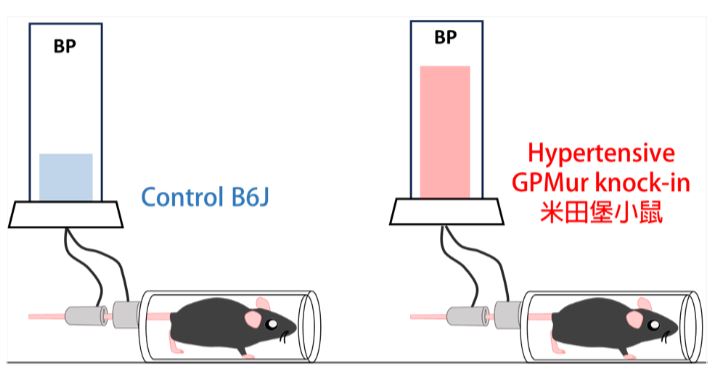Introduction
According to the World Health Organization, hypertension affects one fifth of the world population. The prevalence of hypertension is higher among Southeast Asians (~34%). In Taiwan, a quarter of the local residents ≥ 20 years old are hypertensive. The Miltenberger GPMur blood type is also common in Southeast Asia (2~23% prevalence), and rare elsewhere. We previously found that people with GPMur exhibit higher blood pressure. To unravel this phenomenon, we created the GPMur knock-in mouse model by genetically engineering the common C57BL/6J (B6J) lab strain. The GPMur knock-in mice that express GPMur protein on the red blood cells (RBCs) are hypertensive (7.4~26.8 mmHg higher MAP), which does not shorten their life span or affect their general health. “GPMur-triggered hypertension” is associated with nitric oxide metabolism facilitated by the RBCs. Currently, there are few hypertensive mouse models without comorbidities. This GPMur-hypertension mouse model thus shows tremendous potentials for applications in basic research, preclinical testing and personalized medicine (e.g., pharmaceutical development for the Southeast Asian populations).
Features / strengths
1) The GPMur knock-in mouse has the same genetic blueprint as the standard C57BL/6J lab strain, and thus experiments using it and B6J as the control are cost-effective, and simple and convenient procedure-wise.
2) The GPMur knock-in mouse develops hypertension in young adulthood, without any comorbidities. There is no need to artificially induce hypertension with this mouse strain. These features all greatly simplify data interpretation when experimenting with this mouse strain.
3) In our preliminary tests with different categories of common antihypertensives, GPMur knock-in shows differential drug responses in blood pressure reduction. This demonstrates application potentials of GPMur knock-in in pharmacological research.
Specification in detail
研發中
Seek of partners for business cooperation

